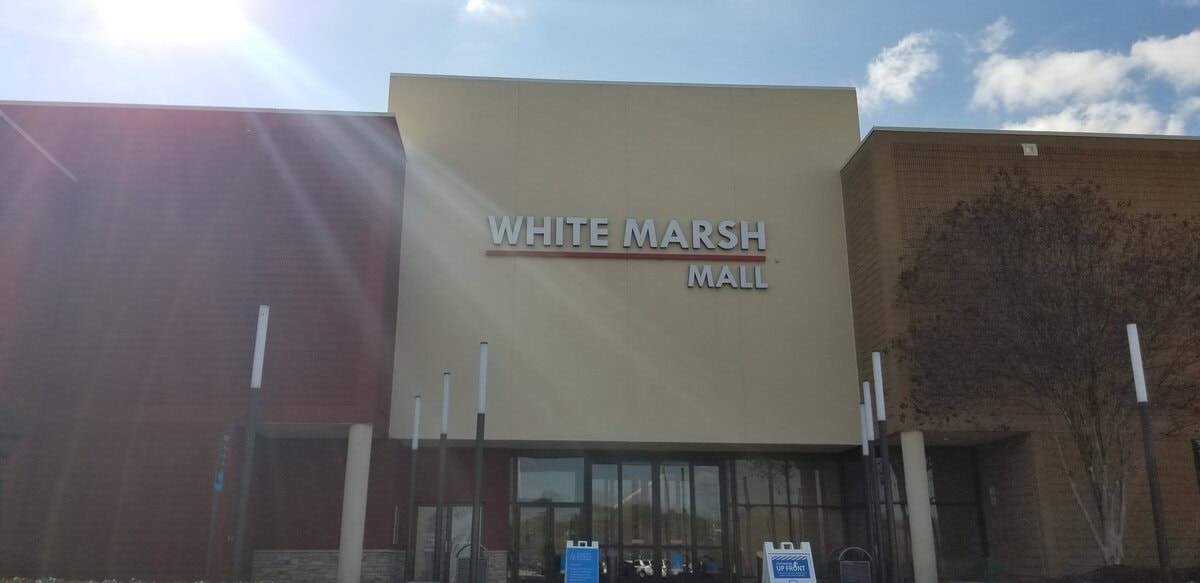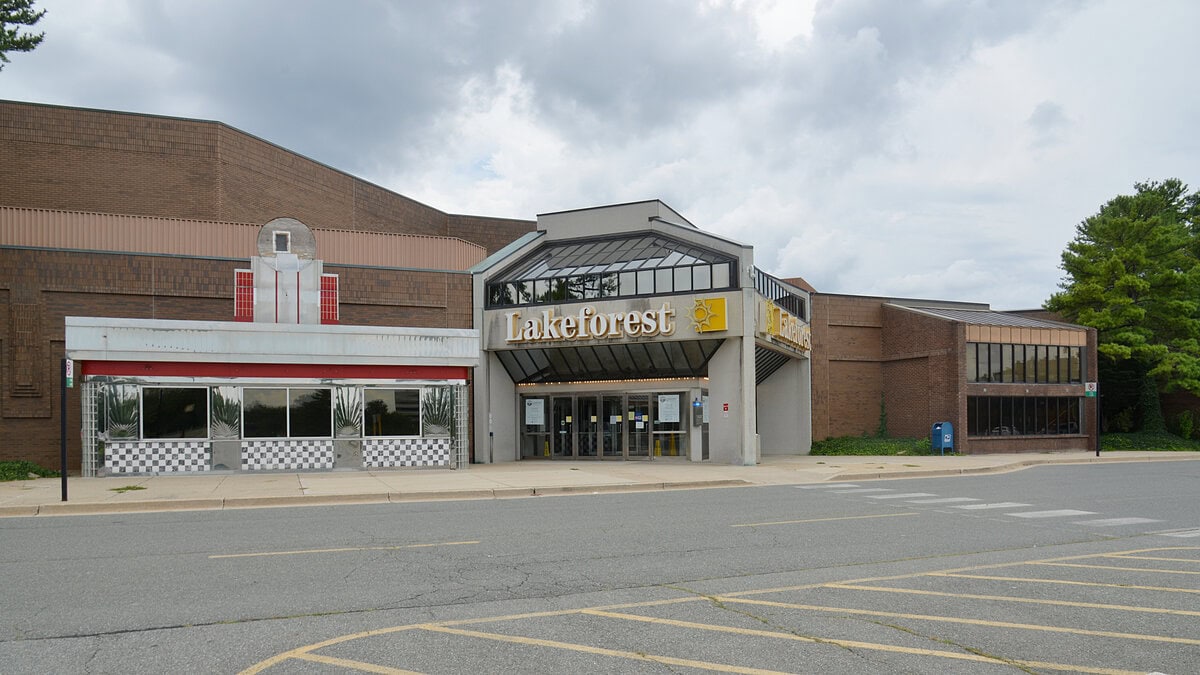When Marley Station Mall Was the Place to Be
In 1987, Marley Station Mall opened in Glen Burnie, Maryland, with Hecht's and Macy's as its first anchors. For a while, the timing worked. The mall quickly caught the attention of national chains and added more anchors through the 1990s. At its peak, it held 130 stores, a movie theater, and six anchor slots.
Families made it a weekend habit. Teenagers paced the halls after school. There were book signings, Santa photos, and crowded food court lunches.
Today, the mood is different. The vacancy is visible. The walkways are quiet. But memories of its heyday still linger.
If you're looking into things to do in Glen Burnie, Maryland, it's hard to ignore the mall's strange half-life: open, yet mostly unoccupied, profitable in pieces, but nowhere near whole.
Breaking Ground - Commercial Foundations and a 1987 Debut
Construction at 7900 Governor Ritchie Highway began under Taubman Centers. The mall officially opened in 1987, with Hecht's and Macy's as its first anchors.
The eight-screen United Artists Theatres debuted in June and is located near the food court.
The timing was deliberate - developers aimed to catch suburban growth and a rising demand for climate-controlled retail space in Anne Arundel County.
Shoppers responded. JCPenney was added in 1994 after being named the most-requested store among customers. Sears came two years later, in 1996, replacing a long-standing Glen Burnie location that had opened in the 1960s.
Retail square footage rose. So did foot traffic. But the construction timeline wasn't without surprises.
By the end of the 1990s, Marley Station Mall was one of the largest enclosed malls in the area. National chains took leases. The anchor count rose to five.
The sixth would come later, but by then, the retail tides had already started to shift.

Ownership Shifts and Tenant Departures (2004-2008)
By 2004, Taubman Centers was out. Ownership had transferred to Mills Corporation, which itself became part of Simon Property Group shortly after.
The anchor lineup shifted that same year. Macy's moved into the Hecht's building in 2006 after its parent company acquired Hecht's parent, May Department Stores.
The original Macy's location didn't stay empty long. Boscov's took over the space in late 2006, making it the only location in Anne Arundel County at the time.
Boscov's filed for bankruptcy in 2008 and shut down its Marley Station store after only two years. Other closures followed across the region, but this one left a prime anchor space dark again.
It wasn't the only vacancy. Several smaller tenants exited, citing soft foot traffic and tightening margins.
Behind the scenes, the numbers weren't reassuring. Simon Property Group faced pressure from lenders, and in March 2013, The Woodmont Company stepped in as court-appointed receiver, managing the property while Bank of America handled the loan dispute.
By that point, the mall was bleeding retail square footage.
One project emerged from the fallout: CyberNAP. In January 2012, AiNET acquired the former Boscov's building with plans to launch a 300,000-square-foot data center.
Vacancy Spike and Commercial Devaluation (2012-2016)
By 2012, Marley Station Mall was visibly thinning out. The vacancy rate had jumped to 44% by the start of the year, up from 33% just twelve months earlier.
This wasn't just a matter of rotating tenants. National retailers were pulling out entirely. Foot traffic dropped, and new leases stopped coming in.
Moody's labeled the mall's debt high risk, warning investors to brace for a 70% loss. On paper, it was underwater, and visibly so.
In 2015, the numbers sharpened the picture. Marley Station Mall was worth $39.8 million against an original $114.4 million loan. By early 2016, that appraisal dropped even further to $31.5 million.
Retail lenders tracked the slide closely. Class ratings on the debt had slipped below investment grade or into default across the board.
That year, Aeropostale closed its location as part of a bankruptcy restructuring. The brand had already flagged dozens of underperforming stores, and Marley Station Mall made the list.
The mall returned to auction that September through the Ten-X platform with a starting bid of $5 million.
A prior $10 million offer from AiNET was turned down. Leasing materials still described the property as viable, but the retail math didn't work anymore. Occupancy was below 75%, with anchor space sitting idle or underused.

Cinema Closure and Asset Repurposing (2014-2016)
The United Artists Theatres opened in 1987 as part of the mall's original launch and closed without warning on February 20, 2014.
After nearly 27 years in operation, the theater simply stopped selling tickets. Just shuttered glass doors and blank posters. At the time, the rest of the mall was already under pressure. Losing the theater didn't help.
Two months later, mall management confirmed that the space would be renovated. Horizon Cinemas stepped in and reopened part of the complex on June 20, 2014.
The rollout came in phases. Four auditoriums were launched immediately. Another four were planned to follow.
New digital projectors, updated concessions, and remodeled restrooms were part of the draw. For a moment, the mall had something new to market again.
In September 2016, the property went back to auction. LNR Properties sold Marley Station to G.L. Harris. The sale closed on December 20, 2016, with a final price of $22.7 million.
But tenant stability still looked fragile. Most new leases were short-term, and many filled old department store floor plans with seasonal pop-ups or temporary concepts.
Auction Disputes and Asset Restructuring (2020-2022)
On September 14, 2020, Marley Station Mall returned to auction. The starting price listed was $1.65 million, with over $15 million in existing debt still attached.
Despite the reduced valuation, the transaction didn't proceed cleanly. In November 2020, the Texas Bankruptcy Court halted the sale.
By then, tenant activity had slowed further, and the mall was back in limbo. At the time, Sears had already confirmed it would close its Marley Station location as part of a national drawdown affecting seven stores.
That closure became final on January 24, 2021, leaving Macy's and JCPenney as the last two traditional anchor tenants.
Even that arrangement was temporary. JCPenney's role faded shortly afterward, though the exact exit date wasn't part of the public release.
Ownership shifted again on June 14, 2022, when a New York-based partnership headed by Mason Asset Management and Namdar Realty Group acquired the mall.
They outlined plans for an aggressive leasing push aimed at filling vacant space. It was the third transfer in less than a decade.
Holiday Events, Gym Traffic, and YouTube Eyes (2023-2025)
In December 2023, the Holiday Train Garden display nearly closed. Volunteer organizers said rising rent made the exhibit unsustainable, even after years of operation inside Marley Station Mall.
After weeks of uncertainty, mall management offered a lease extension through 2026. By then, dismantling had already started, but the crew reversed course.
A new Willy Wonka theme rolled out before Christmas 2024, drawing modest traffic. The exhibit stayed open through January 5, 2025.
Other parts of the mall didn't see the same seasonal lift. By spring, a YouTube video titled "The Story of Marley Station Mall" described the property as "very dead" - a walk-through of mostly empty corridors, punctuated by a few remaining tenants.
One of them was Gold's Gym. In Reddit threads tied to the video, users pointed out that the gym seemed to be the only reason some people still entered the mall.
Several comments speculated that the interior space could close permanently, with only exterior-facing operations like the gym and the last two anchors.
No formal announcement followed, but there were no new anchor deals either.
As of 2025, the status of AiNET's CyberNAP data center at Marley Station Mall is unclear.
While a 2021 LoopNet listing described the 266,400-square-foot space as "built out as a data center" and available for lease, likely referring to unoccupied portions of a larger 300,000-square-foot footprint, later clues cast doubt on whether any operations continued at all.
Google Maps now lists the facility as "permanently closed," and photos of the interior posted to Reddit around two years ago show a stripped-down, unoccupied floor with no racks, cabling, or any infrastructure typically found in an active data center.
The space appeared gutted, lights on but functionally bare.

🍀








wish they're WERE some concrete plans to bring businesses back to MARLEY STATION MALL. Bring some outside unattached activities facilities like a roller skating rink, bowling alley are just some examples of bringing or targeting that generation of people to the area as well as some indoor attractions like Get air. as far as the elderly maintaining Macy's. Maybe a belks or a baskets. Focusing on handicap accessible items areas are extremely important these days.
Your vision for Marley Station Mall is inspiring. Including entertainment facilities and maintaining key stores could indeed attract a diverse crowd. It's essential to consider the needs of older people and those with disabilities.
too bad the mall can't be turned into a senior apartment center with doctors offices
Flat layouts, bus access, and space for clinics - malls are well suited for senior living conversions if someone's willing to take on the zoning and renovation costs.
yes, we do need a roller rink, Bolling alley, an area for the senors can walk. we need several fast food places that serve soups and sandwiches .
Thanks for listing specifics. Vague plans get nods; your ideas feel rooted in actual needs. That's the kind of direction that could help Marley Station serve people again.
As unpopular as the idea may seem, I'm surprised that one of many casino companies have not purchased the mall. It's accessible via Ritchie Hwy, Rt. 100, and has ample parking.
A casino operator might well look at that footprint and see potential. Large buildings, surface lots already in place, and few neighbors likely to object. It's the kind of layout that usually attracts entertainment ventures. However, zoning and local politics may be the hidden barrier.